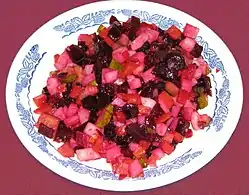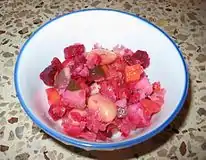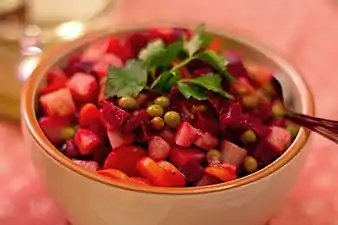Vinegret
Vinegret (Russian: винегрет) or Russian vinaigrette is a salad in Russian cuisine which is also popular in other post-Soviet states. It includes diced cooked vegetables (beetroots, potatoes, carrots), chopped onions, as well as sauerkraut and/or brined pickles.[1][2][3][4] Other ingredients, such as green peas or beans, are sometimes also added.[3][4] The naming comes from vinaigrette,[1] which is used as a dressing.[1][3][4] However, in spite of the name, vinegar is often omitted in modern cooking, and sunflower or other vegetable oil is just used.[2] Some cooks add the brine from the pickled cucumbers or sauerkraut.
 | |
| Alternative names | Russian vinaigrette |
|---|---|
| Type | Salad |
| Course | Appetizers |
| Associated national cuisine | Russian |
| Main ingredients | beet, potato, carrot, onion, sauerkraut and/or brined pickles |
Along with Olivier salad and dressed herring, vinegret is served as zakuska on celebration tables in Russophone communities.
Despite the widespread popularity in Russia and Ukraine, the basic mixed salad recipes were adopted from Western European cuisines as late as the 19th century.[5] Originally, the term vinegret denoted any mixture of diced cooked vegetables dressed with vinegar.[1] Later the meaning changed to any mixed salad with beetroots.[2] Modern Russian and Ukrainian cookbooks still mention the possibility of adding mushrooms, meat or fish,[2][3][4] but this is rarely practiced.
Similar beetroot-based salads are prepared throughout Northern Europe. Examples are herring salad and beetroot salad in North German and Scandinavian cuisines[6] (see also de:Heringssalat, sv:Rödbetssallad), as well as rosolli in Finnish cuisine, with the name for the latter stemming from rassol (Russian: рассол), the Russian word for brine.[7]
 Vinegret with beans
Vinegret with beans Vinegret with green peas
Vinegret with green peas
See also
- List of Russian dishes
 food portal
food portal
References
- Винегрет. In: В. В. Похлёбкин, Кулинарный словарь от А до Я. Москва, Центрполиграф, 2000, ISBN 5-227-00460-9 (William Pokhlyobkin, Culinary Dictionary. Moscow, Centrpoligraf publishing house, 2000; Russian)
- Салаты и винегреты. In: П. В. Абатуров, Л. С. Акулов, А. А. Ананьев и др., Кулинария. Москва, Госторгиздат, 1955-1958 (P. V. Abaturov, L. S. Akulov, A. A. Ananyev etc., Cookery. Moscow, Soviet state publishing house for business literature, 1955-1558; Russian)
- И. А. Фельдман, Любимые блюда. Изд. Реклама, 1988, с. 180-186, ISBN 5-88520-031-9 (I. A. Feldman, Favourite dishes, Reklama publishing house, 1988, p. 180-186; Russian)
- Л. Я. Старовойт, М. С. Косовенко, Ж. М. Смирнова, Кулінарія. Київ, Вища школа, 1992, с. 218 (L. Ya. Starovoit, M. S. Kosovenko, Zh. M. Smirnova, Cookery. Kiev, Vyscha Shkola publishing house, 1992, p. 218; Ukrainian)
- В. В. Похлебкин, Национальные кухни наших народов. Москва, изд. Пищевая пром-сть, 1980 (William Pokhlyobkin, The Ethnic Cuisines of our Peoples. Moscow, Food Industry publishing house, 1980; Russian)
- Modern Cookery. 1845.
- "Salaatti". Raholan syötäviä sanoja. Retrieved 2 June 2018.
External links
| Wikimedia Commons has media related to Vinegret. |
- Vinaigrette Recipe, Russian Recipes
- Vinaigrette Recipe with Sauerkraut and Beans
- Vinaigrette Recipe, Natasha's Kitchen
- Vinegret - Russian Beet and Sauerkraut salad
